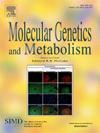TPI deficiency: A case report and review of the literature
IF 3.5
2区 生物学
Q2 ENDOCRINOLOGY & METABOLISM
引用次数: 0
Abstract
Triosephosphate isomerase (TPI) is a ubiquitously expressed enzyme encoded by the TPI1 gene. It catalyzes the interconversion of the triose phosphate isomers dihydroxyacetone phosphate and D-glyceraldehyde 3-phosphate in the fifth step of glycolysis. TPI deficiency (TPI Df; MIM# 615512) is an autosomal recessive disorder due to biallelic pathogenic variants in TPI1. In keeping with other glycolytic enzymopathies, severe hemolytic anemia is a common finding. Additionally, many individuals with TPI Df develop neuromuscular symptoms, which is unusual for a glycolytic enzymopathy. There appears to be a genotype-phenotype correlation between a TPI1 p.Glu105Asp/null genotype and a severe life-limiting neuromuscular phenotype. Tpi1-deficient mice with a p.Glu105Asp/null genotype recapitulate the life-limiting neuromuscular phenotype seen in humans, but the exact pathomechanism remains unclear. Here we describe a 2-month-old male proband who presented with failure to thrive, respiratory failure, seizures, and severe hemolytic anemia, who passed away at 3 months of age. Trio whole genome sequencing showed compound heterozygous variants with the common p.Glu105Asp variant in trans to a newly described likely pathogenic splice site c.324 + 1G > C variant, predicted to cause nonsense mediated decay. Here we review our case as well as the literature to hypothesize a mechanism by which TPI Df due to a p.Glu105Asp/null genotype causes severe disease. Given the overall fatal nature of this condition, novel therapeutic approaches are urgently needed. Currently, treatments are experimental. Ketogenic diet and triheptanoin were effective in treating seizures in a TPI mutant Drosophila, known as TPIsugarkill, although clinical data in humans is lacking. Additionally, bone marrow transplant has been shown to improve the hematologic phenotype in mice and has been done in an isolated number of patients. While there are no proven therapies available at this time, we hope this review will lead the discussion to consider future therapeutic options.
TPI缺陷:一例报告及文献回顾
三磷酸异构酶(Triosephosphate isomerase, TPI)是由TPI1基因编码的一种普遍表达的酶。在糖酵解的第五步催化磷酸三糖异构体磷酸二羟丙酮和3-磷酸d -甘油醛的相互转化。TPI缺乏症(TPI Df; MIM# 615512)是一种常染色体隐性遗传病,由TPI1的双等位基因致病变异引起。与其他糖酵解酶病一致,严重溶血性贫血是一种常见的发现。此外,许多TPI Df患者会出现神经肌肉症状,这在糖酵解酶病中是不常见的。TPI1 p.Glu105Asp/null基因型与严重的限制生命的神经肌肉表型之间似乎存在基因型-表型相关性。具有p.Glu105Asp/null基因型的tpi1缺陷小鼠再现了在人类中看到的限制生命的神经肌肉表型,但确切的病理机制尚不清楚。在这里,我们描述了一个2个月大的男性先证,他表现出发育不全、呼吸衰竭、癫痫发作和严重的溶血性贫血,在3个月大时去世。三人全基因组测序显示,复合杂合变异体与常见的p.Glu105Asp变异体转化为新描述的可能致病剪接位点C .324 + 1G >; C变异体,预测会导致无义介导的衰变。在这里,我们回顾我们的病例以及文献,假设由p.g u105asp /null基因型引起的TPI Df导致严重疾病的机制。鉴于这种疾病的总体致命性,迫切需要新的治疗方法。目前,治疗还处于实验阶段。生酮饮食和三heptanoin对TPI突变果蝇的癫痫发作有效,尽管缺乏人类的临床数据。此外,骨髓移植已被证明可以改善小鼠的血液学表型,并已在孤立的患者中进行。虽然目前还没有有效的治疗方法,但我们希望这篇综述能引导讨论,考虑未来的治疗选择。
本文章由计算机程序翻译,如有差异,请以英文原文为准。
求助全文
约1分钟内获得全文
求助全文
来源期刊

Molecular genetics and metabolism
生物-生化与分子生物学
CiteScore
5.90
自引率
7.90%
发文量
621
审稿时长
34 days
期刊介绍:
Molecular Genetics and Metabolism contributes to the understanding of the metabolic and molecular basis of disease. This peer reviewed journal publishes articles describing investigations that use the tools of biochemical genetics and molecular genetics for studies of normal and disease states in humans and animal models.
 求助内容:
求助内容: 应助结果提醒方式:
应助结果提醒方式:


